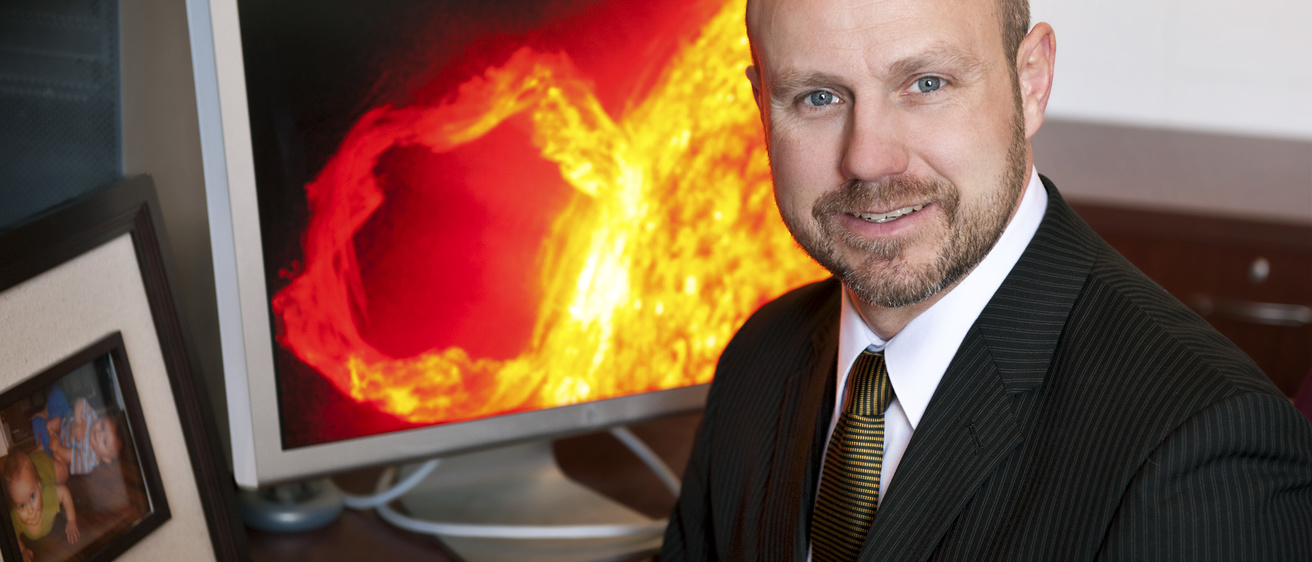The year 2011 wasn't just a good year for Greg Howes, assistant professor of physics and astronomy in the University of Iowa College of Liberal Arts and Sciences. It was a great year.
In February 2011, Howes was named a winner of a National Science Foundation (NSF) Faculty Early Career Development (CAREER) Award. The award comes with a $1 million, five-year NSF grant to fund his studies of the near-Earth solar wind that influences the northern lights and can interfere with satellite-based communications systems. Then in September, President Obama named Howes a recipient of a Presidential Early Career Award for Scientists and Engineers (PECASE) for his NASA-related work and invited him to the White House.
At Iowa, the San Francisco Bay Area native teaches graduate-level courses in plasma physics and in space and astrophysical plasmas, and also college physics for pre-health majors. In a recent interview, he discussed how his work, his family, and his responsibility to others help him keep his career—and the year 2011—in perspective.
First of all, how would you describe your research to a neighbor?
I study turbulence in space, in the solar wind. Turbulence can also be seen in a river. For example, the Iowa River is mostly smooth as it flows along, and that's called a laminar flow. However, when it reaches a spillway and speeds up, the river becomes turbulent. I study how turbulence develops in the solar wind plasma—the particles flowing outward from the sun—and how that turbulence leads to heating in the solar wind.
Why is it important to study space turbulence?
Although the surface of the sun is 6,000 degrees Celsius, the solar corona above the surface is 1 million degrees, and scientists don't understand how that heating occurs, although turbulence is thought to be involved. Understanding how the turbulence in the solar wind plasma leads to heating will shed light on this problem. In addition, the black hole at the center of our galaxy doesn't shine as brightly as expected, and turbulence is likely to play a significant role in the explanation.
How does the solar wind affect us?
Something called space weather can create geomagnetic storms at the Earth, and we would like to be able to predict it. The sun constantly emits matter in the form of a diffuse ionized gas called plasma. Sometimes the sun spits out huge blobs of plasma that shoot out into space as coronal mass ejections. When the particles reach the Earth, they can compress the Earth’s magnetosphere, altering the magnetic field surrounding the planet. The effects range from auroras that can be seen at high latitudes, to electrical system transformer fires or other power grid problems. Also, the signal from GPS satellites can be lost, a problem if you happen to be using GPS to navigate a ship or plane.
I think our country is not prepared for what could happen during a severe space weather storm. In 1859, a solar storm caused fires in telegraph offices, and the northern light to be seen as far south as the Caribbean. A similar incident today could cause billions of dollars in damage to electrical and electronic infrastructure. Some experts have estimated that it could take 10 years to recover from the damage.
What do you find most rewarding about your work?
The most rewarding aspect of my work involves helping coordinate a continuing outreach project of the Department of Physics and Astronomy called Hawk-Eyes on Science. In a typical year, we conduct sessions before the public that reach thousands of people. There’s really an urgent need in the United States to train the next generation of scientists and engineers to keep the country at the forefront of science and technology.
What is your biggest accomplishment personally and professionally?
Personally, it is raising 2-year-old twin boys with my wife. Professionally, it is receiving a PECASE Award from the president recognizing my contributions to NASA. The award is one of promise. So, in presenting it to me and other recipients, President Obama said that if I wanted to come back and eat dinner with him in the White House, I would have to win the nation’s highest award for scientific achievement: the National Medal of Science.
